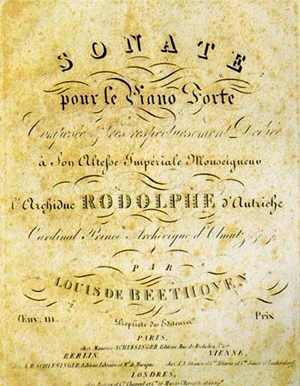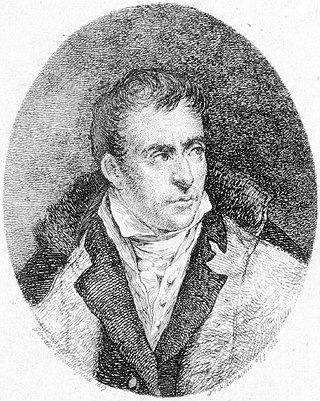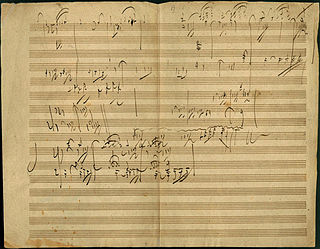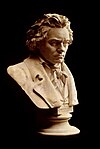Related Research Articles

Ludwig van Beethoven was a German composer and pianist. He is one of the most revered figures in the history of Western music; his works rank among the most performed of the classical music repertoire and span the transition from the Classical period to the Romantic era in classical music. Beethoven's career has conventionally been divided into early, middle, and late periods. His early period, during which he forged his craft, is typically considered to have lasted until 1802. From 1802 to around 1812, his middle period showed an individual development from the styles of Joseph Haydn and Wolfgang Amadeus Mozart, and is sometimes characterized as heroic. During this time, he began to grow increasingly deaf. In his late period, from 1812 to 1827, he extended his innovations in musical form and expression.

Tomaso Giovanni Albinoni was an Italian composer of the Baroque era. His output includes operas, concertos, sonatas for one to six instruments, sinfonias, and solo cantatas. While famous in his day as an opera composer, he is known today for his instrumental music, especially his concertos. He is best remembered today for a work called "Adagio in G minor", attributed to him but largely written by Remo Giazotto, a 20th century musicologist and composer, who was a cataloger of the works of Albinoni.
In music, the opus number is the "work number" that is assigned to a musical composition, or to a set of compositions, to indicate the chronological order of the composer's publication of that work. Opus numbers are used to distinguish among compositions with similar titles; the word is abbreviated as "Op." for a single work, or "Opp." when referring to more than one work. Opus numbers do not necessarily indicate chronological order of composition. For example, posthumous publications of a composer's juvenilia are often numbered after other works, even though they may be some of the composer's first completed works.

The Piano Sonata No. 14 in C-sharp minor, marked Quasi una fantasia, Op. 27, No. 2, is a piano sonata by Ludwig van Beethoven. It was completed in 1801 and dedicated in 1802 to his pupil Countess Julie "Giulietta" Guicciardi. The name Moonlight Sonata grew popular later, likely after Beethoven's death.
Werke ohne Opuszahl (WoO), also Kinsky–Halm Catalogue, is a German musical catalogue prepared in 1955 by Georg Kinsky and Hans Halm, listing all of the compositions of Ludwig van Beethoven that were not originally published with an opus number, or survived only as fragments. The work was originally titled in German Das Werk Beethovens: Thematisch-bibliographisches Verzeichnis seiner sämtlichen vollendeten Kompositionen.

Ferdinando Maria Meinrado Francesco Pascale Rosario Carulli was an Italian composer for classical guitar and the author of the influential Méthode complète pour guitare ou lyre, op. 27 (1810), which contains music still used by student guitarists today. He wrote a variety of works for classical guitar, including numerous solo and chamber works and several concertos. He was an extremely prolific writer, composing over 400 works for the instrument.
Willy Hess was a Swiss musicologist, composer, and famous Beethoven scholar. He achieved fame after compiling and publishing a catalogue of works of Beethoven that were not listed in the "complete" edition. He orchestrated the Piano Concerto No. 0, in E-flat from a piano score.

The Köchel catalogue is a chronological catalogue of compositions by Wolfgang Amadeus Mozart, originally created by Ludwig Ritter von Köchel, in which the entries are abbreviated K. or KV. Its numbers reflect the ongoing task of compiling the chronology of Mozart's works, and provide a shorthand reference to the compositions.
Zur Namensfeier, Op. 115, is a symphonic overture in C major by Ludwig van Beethoven, completed in 1815 and first performed on Christmas Day 1815. It is dedicated to Polish prince Antoni Radziwiłł, who is remembered for his patronage of the arts who supported others like Paganini, Goethe and Chopin. The piece was never one of Beethoven's more popular works and is seldom played today.

"Gertrude's Dream Waltz" is a waltz in B-flat major for solo piano which was attributed by its first publisher to Ludwig van Beethoven. It is catalogued as Anhang 16, nr. 2 in the Kinsky-Halm Catalogue of Beethoven fragments, attributions and works without opus number. There is no evidence that Beethoven wrote the piece; he composed few waltzes, and it is not in the style of any of Beethoven's other compositions.
Kaspar Anton Karl van Beethoven was a brother of the composer Ludwig van Beethoven.

The Catalogues of Beethoven compositions are all of the different ways in which the musical compositions by Ludwig van Beethoven have been organized by researchers into his music.
This article gives an overview of various catalogues of classical compositions that have come into general use.

Alexandre Boucher was a French violinist who performed throughout Europe; he was noted for having a resemblance to Napoleon.

In music, a sketch is an informal document prepared by a composer to assist in the process of composition.

Ludwig van Beethoven (1770–1827) was a German composer in the transition between the classical and romantic period. He composed in many different forms including nine symphonies, five piano concertos and a violin concerto. Beethoven's method of composition has long been debated among scholars. His sketches of composition drafts, and his written letters, provide contrasting evidence about his process of composition. However, many scholars agree that, for him, composition was a slow and laborious process. It is clear that his deafness impacted his compositional style, as evinced in certain changes in compositional method from early to late in his career.

Ludwig van Beethoven composed at least six works for mandolin, four of which survive. None were published during his lifetime. Though known better as a pianist, Beethoven possessed a Milanese mandolin, which was hung beside his piano. He was friends with two prominent mandolinists, both of whom were linked to his surviving mandolin music.
Giovanni Biamonti was an Italian musicologist best known for his work on the composer Ludwig van Beethoven. Administrative secretary of the Accademia Nazionale di Santa Cecilia from 1924 to 1963, Biamonti's greatest achievement was his eponymous catalogue of Beethoven's complete works, including many not contained in either the Beethoven Gesamtausgabe, or Kinsky/Halm or Hess catalogues. Arranged chronologically, it contains a total of 849 works, including sketches and fragments stretching from the variations for piano on a march by Ernst Christoph Dressler of 1782 to Beethoven's last bars in 1827.
